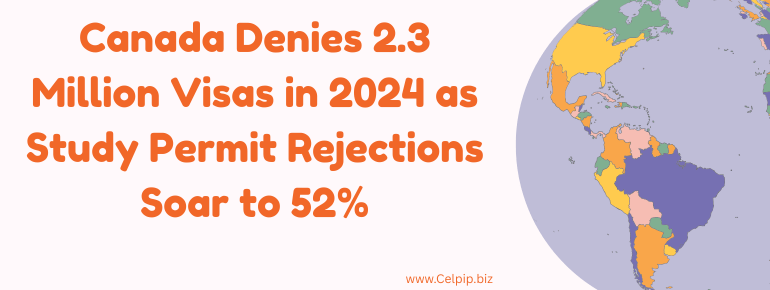In 2024, Canada faced a significant tightening of its immigration policies, resulting in the rejection of over 2.3 million temporary resident applications, the highest rate recorded in the country’s history.
This drastic shift reflects growing public concern over rising living costs and housing shortages, prompting the federal government to reassess its approach to temporary immigration.
Record Visa Rejections
According to data from Immigration, Refugees and Citizenship Canada (IRCC), a total of 2,359,157 temporary resident applications were denied in 2024, up from 1,846,180 in 2023.
This represents a staggering increase in rejection rates from 35% to 50% within just one year. The breakdown of these refusals reveals alarming trends across various visa categories:
- Visitor Visas: Approximately 1.95 million visitor visa applications were rejected, accounting for 54% of all such requests. This marks a significant rise from the previous year’s rejection rate of 40%.
- Study Permits: The rejection rate for study permits surged to 52%, a sharp increase from 38% in 2023. This translates to around 290,317 study permit applications being denied.
- Work Permits: Although slightly improved, work permit refusals still affected 22% of applicants, with 115,549 applications turned down.
Underlying Causes
The surge in visa rejections is largely attributed to mounting pressure on the Canadian government to address issues related to affordability and housing.
Many citizens have voiced concerns about the impact of temporary residents on local resources and living conditions. In response, Ottawa has revised its targets for permanent residency significantly—cutting goals by 20% for the years 2025 through 2027.
The new targets are set at 395,000 for 2025, followed by 380,000 in 2026 and 365,000 in 2027.
Legal Implications for Migrants
Despite the aggressive rejection policies, many temporary residents are finding ways to extend their stay.
Applications for visitor records—documents that allow migrants to remain in Canada without granting work or study rights—have nearly doubled from about 196,965 in 2019 to 389,254 in 2024.
While these applications have a high approval rate of approximately 95%, they contribute to a growing backlog in processing times, which currently can stretch up to 119 days.
This tightening of immigration policies is not unique to Canada; it reflects broader trends seen globally where countries like Australia, the UK, and the US are also experiencing declines in international student enrollments.
In Canada specifically, student visa applications fell by an astonishing 46%, dropping from 868,000 in 2023 to just 469,000 in 2024.
The record number of visa rejections marks a pivotal moment for Canada’s immigration landscape as it grapples with balancing public sentiment against the need for foreign talent and tourism.
As policies continue to evolve in response to economic pressures and societal needs, potential applicants must navigate an increasingly complex immigration environment marked by heightened scrutiny and stringent requirements.




